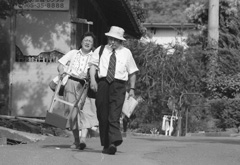CLOSING FILM YIDFF 2009
Minamata Diary: Visiting Resurrected Souls
(“Minamata nikki: Yomigaeru tamashii o tazunete”) JAPAN / 2004 / Japanese / Color / Video / 100 min
JAPAN / 2004 / Japanese / Color / Video / 100 min
Director, Editing: Tsuchimoto Noriaki
Assistant: Tsuchimoto Motoko
Sound: Kubota Yukio
Video Correction: Kojima Yoshitaka (S.M. Service)
Music, Performance: Kina Shokichi & Champloose
Production, Source: Cine Associé www2.ocn.ne.jp/~tutimoto/
Tsuchimoto Noriaki, a leading figure in Japanese documentary film, passed away on June 24, 2008. His many films and writings from the 1960s onwards, including his representative Minamata series, display an attitude of engaged reflection on the world. His last film, Minamata Diary, is a personal documentary that he shot himself. Commenting that “filming lets me feel I can breathe deeply, and it’s a great change of pace,” this is a youthful film with a light touch, made together with his companion Motoko.
 Tsuchimoto Noriaki (1928–2008)
Tsuchimoto Noriaki (1928–2008)
Born on December 8, 1928, in Toki, Gifu Prefecture, Tsuchimoto joined Iwanami Productions in 1956. After directing An Engineer’s Assistant (1963), he went freelance and made On the Road (1964), Pre-Partisan (1969) and other films. Beginning in the 1970s, he directed a series of films on Minamata, and in 1977, held screenings in 133 coastal villages at 99 locations over 100 days, on his “Shiranui Sea: A Film Crew Across the Sea” tour. In June 2003, he was a featured artist at the 49th Flaherty Seminar in New York. He died of lung cancer on June 24, 2008, leaving behind his last film, Minamata Diary: Visiting Resurrected Souls (2004). His writings include Film Is the Job of Living Creatures and Records in Misfortune. In the summer of 2009, the National Film Center (The National Museum of Modern Art, Tokyo) hosted a two-month exhibition and film retrospective. |
The Story of Minamata Diary
Beginning in November 1994, Tsuchimoto Noriaki and I lived in Minamata for a year.
This wasn’t to make a film, but to create what we called “the ranks of the Minamata Disease dead” for the Minamata Tokyo Exhibition in 1996. We devoted ourselves to visiting bereaved families with a camera to reproduce photographs of the dead, but the fact is, it was a struggle to gather the photographs.
Our goal was to memorialize the names and faces of the victims, in the hope that the tragedy of Minamata Disease will never be repeated, but among the families there were some who simply wanted to forget. The gulf between our feelings and those of the families resulted in stress, and the fatigue wore us down. Here is what Noriaki wrote about that time:
“During those days, I picked up the camera as a kind of escape. Filming those moments was comforting, and it allowed me to breathe deeply before the next day. But, in the end, it was also a pleasure to film people through the seasons, the events, and the patients’ behavior. And there were subtle discoveries and surprises in the landscape we thought we knew well. Buoyed by these pleasures, we managed to gather the images of 500 people in the space of a year.”
Noriaki shot the footage on Hi8 using a Handycam and a Handycam Pro. I recorded the sound using a Sennheiser microphone. In the end, we had twenty-plus hours of video footage. This we edited down to two hours and screened for the public at the Minamata Tokyo Exhibition with live narration by Noriaki. This one-time-only screening was well received, and Noriaki’s narration was preserved.
He later wrote the following:
“I watched the rough cut of the film again after a space of several years, and discovered something new in it. Acting in defiance of decay, the spirit of Minamata had become serene. Could we call this the water level that the soul of Minamata had attained, through long suffering? A direction that pointed toward the future was hidden in the footage. Perhaps this was the camera’s deception. At the same time, finishing the film was, for us, an unexpected ‘resurrection.’”
I am very pleased to present the record of Tsuchimoto Noriaki and my year in Minamata.
(Tsuchimoto Motoko)
